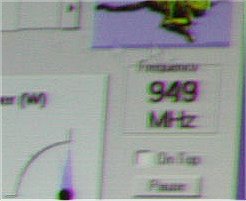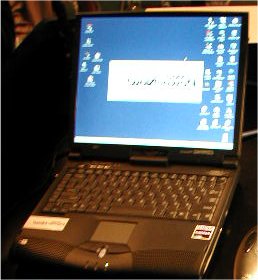AMD Launch Mobile Units
‘Athlon 4 gets its UK launch’Followings yesterdays launch of the Athlon 4, we went to the AMD UK launch of these units in London, in case you have been asleep the Athlon 4 is AMD’s new Palomino branch of processors. They launched the new Mobile Duron today, and also showed us some Mobile Units running the Athlon 4 CPU.
The AMD Panel, with VIA Vice President of Corporate Marketing.

‘This new breed of power in a Mobile format’
We first saw the mobile AMD solution behind closed doors at CeBIT earlier this year and were very impressed with the performance of this unit, there being major advantages to using an AMD based mobile solution. Ever since the Thunderbird socket A desktop CPU was released from AMD people have noticed there are a few apparent issues with it.
‘Heat’ Within the core of the CPU there are a large number of transistors, this coupled with the small core size and the high speed of the unit means a large amount of heat is dissipated. AMD were faced with a problem due to this. As the Thunderbird based core was limited to a desktop market fitted with a large heatsink. To make a mobile Athlon a viable option they had to solve the heat issue. So what did they do? they lowered the core voltage for starters a 1000Mhz Athlon 4 now runs at just 1.4Volts, and introduced a new technology as outlined below to help combat considerably the heat problem.
‘PowerNow’ Apart from the heat issues, which AMD had solved, they also had to create a way of keeping the power usage down, this is where the new technology kicks in. AMD developed an intelligent form of power saving technology called PowerNow. This is like lntels Speedstep, but makes a lot more sense.
‘PowerNow Vs SpeedStep’ With lntels solution it has 2 forms, the CPU can run at core speed or it can run at around 200MHz less these 2 forms work in 2 states. When the laptop is in mobile mode it will run at the slower speed, this is a native way of saving battery power but you were right in thinking that this is very simplistic solution. You end up buying a 700MHz unit and it runs a lot slower at only 500MHz on battery power.
The way the AMD PowerNow solution runs is that the computer can drag as much power and speed as it needs so lf you are only searching the net or writing a letter it will cut the speed on-the-fly. This then conserves battery power, The CPU speed and voltage are adjusted on the fly between 500MHz and 1.2Volts right up to the maximum speed of the CPU where it draws just 1.4Volts, This is considerably lower than the 1.75 volts of the desktop 1000MHz Thunderbird CPU. The PowerNow specs state that between the base PowerNow speed of 500MHz and the maximum CPU operating speed there are 32 different possible speed/voltage configurations. This means the battery will last as long as it possibly can, and yet still gives the user the speed they paid for. We first saw this on demo at CeBIT and it was most strange to see the speed change LIVE on the spot in Windows.


Here you can see that the speed changed on the fly, this was by the AMD 1Ghz Athlon 4 Unit within the Compaq Laptop. Notice the CPU Utilisation and the Power Usage.
The most recent core from AMD was launched today the Palomino. This same core development will be used in: -
-
Mobile
-
Workstation
-
Server in single and 2 way environment
-
And for desktop
What about performance?
One question which you all need the answer for, is what performance increase will the Athlon 4 have over the Thunderbird Athlon? Well there will be around 15% increase in overall speed. (When compared clock for clock.)
So what’s new about the Athlon 4?
Well there have been a number of key changes.
-
37.5 million Transistors
-
128mm (sq) die
-
384k cache with data pre fetch (note this is data, not instructions.)
-
52 new instructions (3DNow Professional.)
-
AMD PowerNow technology
-
Low voltage operation
-
Thermal diode
A lot of changes and improvement, I am sure you can see.
With the other changes including the above the Duron is still with 192K cache as it is aimed at the budget market. The overall advantage of PowerNow is that it saves batteries by around 30% without the loss of speed. VIA, there chipset partner, currently has 80 percent market share (global scale.) with the company now worth around $1 billion.
Within the PowerNow operation there are 3 main options for the settings, PowerNow works as a layer above ACPI.
The following options for PowerNow are: -
-
Automatically This is where the system automatically syncs in with whatever it needs.
-
Highest performance this is where you can force it on full clock speed.
-
Battery saving. This is where you specify the slowest speed possible for the system to run.
‘AMD set to enter the Commercial sector’
AMD have had massive success over the past year with a 40% pc share 77% growth in the year. AMD are now focusing on the commercial world with a massive 118% increase in shipments. Most noticeable is in fact that Intel has suffered an 8% drop.
Their main aim and current development is a One software, One socket solution. Which allows scaling to 760MP and also in to other areas such as High-end server. The reason for this is so that any user can upgrade from a Duron to a high end Athlon 4.
They have just launched the Palomino, which as stated is the latest revision, they will support Socket A until Q4 2002 at the minimum.
Within the laptop is a socket A interface this allows a clear upgrade path for your laptop. AMD said Socket A will be here until at least 2002 [end of] this gives more faith in the user for upgrades. They expect the launch of the workstation, SMP and desktop Athlon 4’s to be in Q2 and Q3. They are also planning a Duron based SMP machine for the later half of 2001. Hewlett Packard and Compaq are working on the laptops together with other OEMs.

Some Rendering Done on the Laptop (Very fast and smooth)
Laptop Chipset options: -
-
KT133A with full PowerNow 2.0 support [aimed at high end desktop replacement]
-
Twisterk AKA the VIA ProSavage KN133, with integrated s3 savage4 core. [Aimed at entry level and super light.]
KN133
-
128bit 2D core 3D support from the Savage4+.
-
200/266 FSB support
-
Pc100/133 memory
-
SMA frame buffer
-
Integrated savage 4 graphics
-
Integrated DSTN and dual channel LVDs
-
Advanced PowerNow 2.0 support.
Graphics overview:
-
8kb texture cache
-
Integrated DSTN Support
-
DVD motion compensation [30fps]
-
32bit rendered
-
Bump mapping
-
S3tc texture compression
-
AGP 4x side banding
The KN133 SMA Northbridge interfaces with a VT8231 Southbridge. This has full PC133 support.
We should see the KN133 laptops in the shops q3 2001. We managed to have a look at the Compaq Presario 1200, using a 1 GHz Athlon 4. It was fast with 3D graphics from ATI the chipset was based on the KT133A

Apparently NVIDA are working on the NV11 Crush, this is an integrated Northbridge and Graphics chipset for a laptop design. The AMD Athlon 4 coupled with a NVIDIA geforce2go will give a menace of a machine, it will allow people to play high speed games, and use more graphically demanding programs.
A Word from the Top: - CEO of AMD stated: -
‘How do you beat an 800lb Gorilla? Make friends with lots of 400lb gorillas’ this is AMD’s main “motto”
A thank you to AMD for holding this press day, it was most informative... and Hexus got through the day without breaking anything ;)













